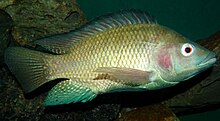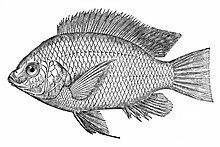
Cichlids are fish from the family Cichlidae in the order Cichliformes. Traditionally Cichlids were classed in a suborder, the Labroidei, along with the wrasses (Labridae), in the order Perciformes, but molecular studies have contradicted this grouping. On the basis of fossil evidence, it first appeared in Tanzania during the Eocene epoch, about 46–45 million years ago. The closest living relative of cichlids is probably the convict blenny, and both families are classified in the 5th edition of Fishes of the World as the two families in the Cichliformes, part of the subseries Ovalentaria. This family is large, diverse, and widely dispersed. At least 1,650 species have been scientifically described, making it one of the largest vertebrate families. New species are discovered annually, and many species remain undescribed. The actual number of species is therefore unknown, with estimates varying between 2,000 and 3,000.

Tilapia is the common name for nearly a hundred species of cichlid fish from the coelotilapine, coptodonine, heterotilapine, oreochromine, pelmatolapiine, and tilapiine tribes, with the economically most important species placed in the Coptodonini and Oreochromini. Tilapia are mainly freshwater fish inhabiting shallow streams, ponds, rivers, and lakes, and less commonly found living in brackish water. Historically, they have been of major importance in artisanal fishing in Africa, and they are of increasing importance in aquaculture and aquaponics. Tilapia can become a problematic invasive species in new warm-water habitats such as Australia, whether deliberately or accidentally introduced, but generally not in temperate climates due to their inability to survive in cold water.
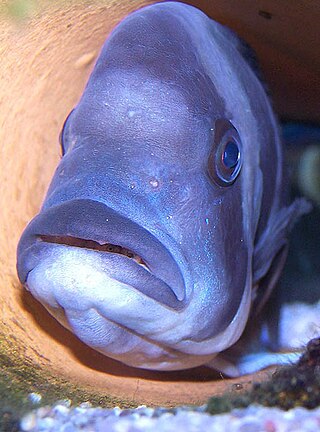
Mouthbrooding, also known as oral incubation and buccal incubation, is the care given by some groups of animals to their offspring by holding them in the mouth of the parent for extended periods of time. Although mouthbrooding is performed by a variety of different animals, such as the Darwin's frog, fish are by far the most diverse mouthbrooders. Mouthbrooding has evolved independently in several different families of fish.

Oreochromis is a large genus of oreochromine cichlids, fishes endemic to Africa and the Middle East. A few species from this genus have been introduced far outside their native range and are important in aquaculture. Many others have very small ranges; some are seriously threatened, and O. ismailiaensis and O. lidole possibly are extinct. Although Oreochromis primarily are freshwater fish of rivers, lakes and similar habitats, several species can also thrive in brackish waters and some even survive in hypersaline conditions with a salinity that far surpasses that of seawater. In addition to overfishing and habitat loss, some of the more localized species are threatened by the introduction of other, more widespread Oreochromis species into their ranges. This is because they—in addition to competing for the local resources—often are able to hybridize.

The Tilapiini are a tribe within the family Cichlidae commonly known as tilapiine cichlids. Formerly this tribe contained many other genera and species, including the economically important Oreochromis and Sarotherodon, but a taxonomic review found that this grouping was paraphyletic and most were moved to Coelotilapini, Coptodonini, Heterotilapini, Oreochromini and Pelmatolapiini. Together, most species in these tribes are called "tilapias". In a more distant past, a number of other, more different genera like Steatocranus also were included in Tilapiini. With these as separate, Tilapiini now is a much more restricted tribe with only three genera and about half a dozen species from Central and Southern Africa.
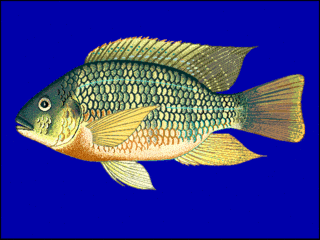
Tilapia has become the third most important fish in aquaculture after carp and salmon; worldwide production exceeded 1.5 million metric tons in 2002 and increases annually. Because of their high protein content, large size, rapid growth, and palatability, a number of coptodonine and oreochromine cichlids—specifically, various species of Coptodon, Oreochromis, and Sarotherodon—are the focus of major aquaculture efforts.
Throughout much of the tropics, tilapiine cichlids native to Africa and the Levant have been widely introduced into a variety of aquatic systems. In the U.S. states of Florida and Texas, tilapia were originally introduced to curtail invasive plants. In an effort to meet the growing demand for tilapia, humans have farmed these fish in countries around the world. Capable of establishing themselves into new ponds and waterways, many tilapia have escaped aquaculture facilities across much of Asia, Africa, and South America. In other cases, tilapia have been established into new aquatic habitats via aquarists or ornamental fish farmers.

The Mozambique tilapia is an oreochromine cichlid fish native to southeastern Africa. Dull colored, the Mozambique tilapia often lives up to a decade in its native habitats. It is a popular fish for aquaculture. Due to human introductions, it is now found in many tropical and subtropical habitats around the globe, where it can become an invasive species because of its robust nature. These same features make it a good species for aquaculture because it readily adapts to new situations. It is known as black tilapia in Colombia and as blue kurper in South Africa.
The silver cyprinid also known as the Lake Victoria sardine, mukene, and omena, dagaa (Swahili) is a species of pelagic, freshwater ray-finned fish in the carp family, Cyprinidae from East Africa. It is the only member of the genus Rastrineobola.
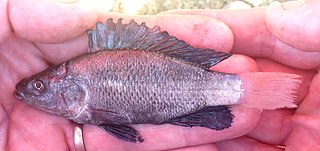
Oreochromis amphimelas is a species of tilapia cichlid endemic to north–central Tanzania, where it is found in Lake Manyara and a number of other saline lakes with closed basins. Maximum recorded size is 28 cm (11 in) in standard length.

Oreochromis esculentus, the Singida tilapia or Graham's tilapia, is a species of cichlid endemic to the Lake Victoria basin, including some of its satellite lakes such as Kyoga, in Tanzania, Uganda, and Kenya. Its common name refers to Lake Singida, but this population is the result of an introduction that happened in the 1950s. This fish is highly valued by local fishermen, who know it as ngege.
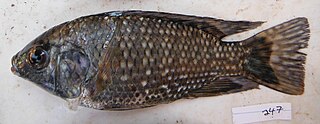
Oreochromis leucostictus is a species of cichlid native to Albertine Rift Valley lakes and associated rivers in DR Congo and Uganda. It has now been introduced widely elsewhere East Africa, and is believed to have negative ecological impact, particularly on native tilapias. This species is reported to reach a standard length of up to 36.3 cm (14.3 in), but is usually much smaller. It is exploited by small-scale fishery and aquaculture operations.
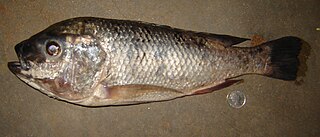
Oreochromis lidole is a species of freshwater fish in the family Cichlidae. This tilapia is native to Malawi, Mozambique and Tanzania, where it is found in Lake Malawi, Lake Malombe, the Shire River and perhaps some crater lakes further north. It is important in fisheries, but has drastically declined; it may already be extinct. This oreochromine cichlid is locally called chambo, a name also used for two other closely related species found in the same region, O. karongae and O. squamipinnis.

Oreochromis variabilis, the Victoria tilapia, is a species of African cichlid native to Lake Victoria and its tributaries, Lake Kyoga, Lake Kwania, and Lake Bisina (Salisbury), as well as being found in the Victoria Nile above Murchison Falls. This species can reach a standard length of 30 cm (12 in). This species is important to local commercial fisheries and is potentially important in aquaculture. It is also found in the aquarium trade.
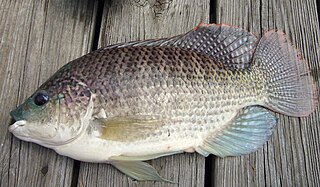
The blue tilapia is a species of tilapia, a fish in the family Cichlidae. Native to Northern and Western Africa, and the Middle East, through introductions it is now also established elsewhere, including parts of the United States, where it has been declared an invasive species and has caused significant environmental damage. It is known as the blue kurper in South Africa.

The mango tilapia is a species of fish from the cichlid family that is native to fresh and brackish waters in Africa and the Levant. Other common names include Galilaea tilapia, Galilean comb, Galilee St. Peter's fish, and St. Peter's fish. This is a relatively large cichlid at up to 41 centimetres (16 in) in total length and about 1.6 kilograms (3.5 lb) in weight. It is very important to local fisheries and the species is also aquacultured.
There are two major sources of fish in Uganda; one is from aquaculture, the other from fishing in rivers and lakes. Different types of fish flourish in different water sources. The waters of Uganda contain an impressive array of fish species—over 90 in all. This count does not include the Haplochromis complex, which itself is made up of more than 200 species.

The redbelly tilapia, also known as the Zille's redbreast tilapia or St. Peter's fish, is a species of fish in the cichlid family. This fish is found widely in fresh and brackish waters in the northern half of Africa and the Middle East. Elsewhere in Africa, Asia, Australia and North America, it has been introduced as a food fish or as a control of aquatic vegetation. Where introduced, it sometimes becomes invasive, threatening the local ecology and species. The redbelly tilapia is an important food fish and sometimes aquacultured.

Oreochromini is a tribe of cichlids in the Pseudocrenilabrinae subfamily that is native to Africa and Western Asia, but a few species have been widely introduced to other parts of the world. It was formerly considered to be part of the tribe Tilapiini but more recent workers have found that the Tilapiini sensu lato is paraphyletic. Despite this change, species in Oreochromini are still referred to by the common name tilapia and some of the most important tilapia in aquaculture —certain species of Oreochromis and Sarotherodon— are part of this tribe. In contrast, several species have small ranges and are seriously threatened; a few are already extinct or possibly extinct.
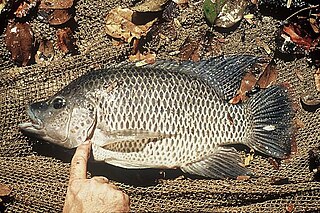
Oreochromis mortimeri, the Kariba tilapia or kurper bream, is a species of cichlid, formerly classified as a Tilapiine cichlid but now placed in the genus Oreochromis, the type genus of the tribe Oreochromini of the subfamily Pseudocrenilabrinae. It is found in the rivers of south central Africa especially the middle Zambezi where it is endangered by the spread of invasive congener Oreochromis niloticus.

